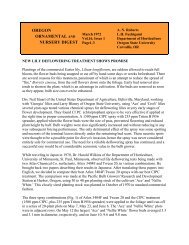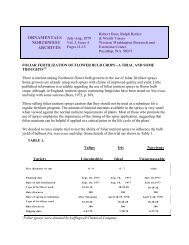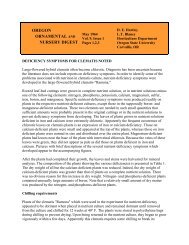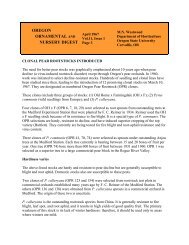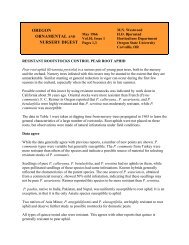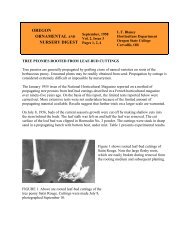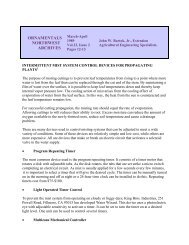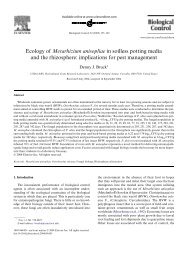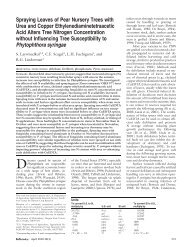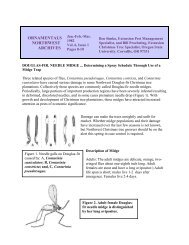Weed Control in Tall Bearded Iris; A Field Study with Six Herbicides ...
Weed Control in Tall Bearded Iris; A Field Study with Six Herbicides ...
Weed Control in Tall Bearded Iris; A Field Study with Six Herbicides ...
Create successful ePaper yourself
Turn your PDF publications into a flip-book with our unique Google optimized e-Paper software.
ORNAMENTALSNORTHWESTARCHIVESSept.-Oct. 1987Vol.11, Issue2Pages 19-20Richard Regan OSU ExtensionHort. Agent, Salem, ORRay William, OSU Extension <strong>Weed</strong>Specialist, Corvallis, ORRay Schre<strong>in</strong>er, Schre<strong>in</strong>er’s Gardens, Inc.Salem, ORWEED CONTROL IN TALL BEARDED IRIS: A FIELD STUDY WITH SIXHERBICIDES, 1986.<strong>Herbicides</strong> are used for weed control when produc<strong>in</strong>g tall bearded iris rhizomes. Althoughcultivation is used, preemergence herbicides control many of the problem weeds. <strong>Herbicides</strong>reduce the amount of hand hoe<strong>in</strong>g and subsequent damage to the shallow rhizomes. Registeredherbicides for this use are limited and phytotoxicity is often a concern. <strong>Six</strong> materials,metolachlor, napropamide, oryzal<strong>in</strong>, oxadiazon, oxyfluorfen, and simaz<strong>in</strong>e, be<strong>in</strong>g considered foruse <strong>in</strong> tall bearded iris were tested for phytotoxic effects and for their effectiveness <strong>in</strong> controll<strong>in</strong>g<strong>in</strong>digenous weeds.Procedures: A field trial was established <strong>in</strong> the Salem area of the Willamette Valley, 1985.Treatments, described <strong>in</strong> Table 1, consisted of various rates or comb<strong>in</strong>ations of metolachlor,simaz<strong>in</strong>e, oryzal<strong>in</strong>, napropamide, oxadiazon, oxyfluorfen + oryzal<strong>in</strong>, and an untreated checkapplied over-the-top one day after plant<strong>in</strong>g the tall bearded iris cultivar "Stepp<strong>in</strong>g Out." <strong>Iris</strong>rhizomes were planted on September 9, 1985, at a depth of 1/2 to 3 <strong>in</strong>ches <strong>in</strong> a Woodburn siltloam. The number of rhizomes <strong>in</strong> each plot ranged between 4 to 10 and averaged 6.4.Comb<strong>in</strong>ation treatment plots received separate applications of oryzal<strong>in</strong> <strong>in</strong> the fall, simaz<strong>in</strong>e <strong>in</strong> thew<strong>in</strong>ter, and napropamide <strong>in</strong> the spr<strong>in</strong>g.Treatments were applied September 19, 1985 to dry soil surfaces as either a spray or granularbroadcast. Spray materials were applied <strong>in</strong> a water carrier at the rate of 60 gallons per acre <strong>with</strong> aCO 2 backpack sprayer us<strong>in</strong>g two flat fan type 8003 nozzles on an 18 <strong>in</strong>ch boom, while thegranular materials were spread uniformly over the plot <strong>with</strong> a glass quart shaker. All treatmentsreceived 0.5 to 1.0 <strong>in</strong>ches of irrigation 20 hours after application. Air temperature was 66 degreesF and soil temperature was 67 degrees F. Comb<strong>in</strong>ation treatment plots received additionalapplications of simaz<strong>in</strong>e on January 8, 1986, and napropamide on April 18, 1986. Theseadditional treatments receive 0.2 to 0.5 <strong>in</strong>ches of ra<strong>in</strong>fall 2 to 6 days follow<strong>in</strong>g application.Individual plot size was 3 x 6 feet and each treatment was replicated four times <strong>in</strong> a randomizedcomplete block experimental design. Fluazifop-butyl was applied to all plots <strong>in</strong> March at the rateof 0.12 lb ai/A to control grass weeds. No other herbicides were applied to the trial site. Theuntreated check was hand weeded. Standard cultural practices for iris production were followedfor the crop rotation.Annual ryegrass, curly dock, and wild carrot weed control rat<strong>in</strong>gs were recorded on November11, 1985, 47 days after treatment applications. When the November 11, 1985 weed control rat<strong>in</strong>gwas done, oryzal<strong>in</strong> was the only herbicide applied <strong>in</strong> the treatments where simaz<strong>in</strong>e and
napropamide were to be added at a later date. Leaf area was rated on June 3, 1986, 257 days afterapplication by visual exam<strong>in</strong>ation. Rhizome fresh weights were measured on June 17, 1986, 271days after treatments were applied. <strong>Iris</strong> leaves were removed just above the rhizome grow<strong>in</strong>g tip<strong>with</strong> a sharp knife before weigh<strong>in</strong>g.Results and discussion: The average efficacy of weed control for fall populations of annualryegrass, curly dock, and wild carrot is shown <strong>in</strong> Table 1. Annual ryegrass control <strong>in</strong> all plotsconta<strong>in</strong><strong>in</strong>g metolachlor, oxadiazon, and oxyfluorfen + oryzal<strong>in</strong> was good. Simaz<strong>in</strong>e and oryzal<strong>in</strong>were not effective at the lowest rate although control did improve <strong>with</strong> an <strong>in</strong>crease <strong>in</strong> rate.<strong>Control</strong> of annual ryegrass was not satisfactory at any rate of napropamide. Metolachlor,simaz<strong>in</strong>e, oxadiazon, and oxyfluorfen + oryzal<strong>in</strong> were very effective <strong>in</strong> controll<strong>in</strong>g curly dock.Satisfactory control was obta<strong>in</strong>ed only at the highest rates of oryzal<strong>in</strong> and napropamide. Wildcarrot control <strong>with</strong> simaz<strong>in</strong>e, oxadiazon, and oxyfluorfen + oryzal<strong>in</strong> was very good. Therema<strong>in</strong><strong>in</strong>g materials did not give satisfactory control.Phytotoxicity was observed <strong>in</strong> iris by reductions <strong>in</strong> leaf area and rhizome fresh weight. <strong>Iris</strong> <strong>in</strong>affected plots had reduced leaf areas caused by slight to severe leaf tip burn and reduced growth.The highest rate of simaz<strong>in</strong>e significantly reduced rhizome fresh weight and caused severe leaftip burn. Although slight to moderate tip burn was observed at the lower rates of simaz<strong>in</strong>e,rhizome fresh weight was not affected. Slight to moderate growth reduction was observed <strong>in</strong>plots conta<strong>in</strong><strong>in</strong>g oryzal<strong>in</strong>, napropamide, oxyfluorfen + oryzal<strong>in</strong>, and the comb<strong>in</strong>ation treatments.Metolachlor at the highest treatment rate affected leaf area because of slight leaf tip burn.Growth reduction of iris was very slight <strong>in</strong> oxadiazon plots. No significant difference wasobserved <strong>in</strong> rhizome fresh weight other than the highest rate of simaz<strong>in</strong>e.Table 1. <strong>Weed</strong> control and effect on tall bearded iris "Stepp<strong>in</strong>g Out" <strong>with</strong> six herbicides,1985-86.<strong>Weed</strong> <strong>Control</strong> Rat<strong>in</strong>g 2 Phytotoxicity to <strong>Iris</strong>annual curly wildryegrass dock carrot3 leafareareduction4 rhizomefreshTreatment )(lb ai/A)Untreated check 0.0 0.0 0.0 0.0 135.0a 5metolachlor 8E (2.0) 6.8 8.8 0.8 0.1 134.8ametolachlor 8E (4.0) 7.8 7.9 6.0 0.0 113.4abmetolachlor 8E (8.0) 8.2 9.9 6.5 1.5 139.9asimaz<strong>in</strong>e 80WP (1.6) 2.8 8.5 9.1 0.2 146.6asimaz<strong>in</strong>e 80WP (3.2) 8.9 10.0 9.5 0.6 144.3asimaz<strong>in</strong>e 80WP (6.4) 6.2 9.5 8.9 3.0 79.8boryzal<strong>in</strong> 4.OAS (2.0) 2.8 5.0 3.8 0.5 123.7aboryzal<strong>in</strong> 4.OAS (4.0) 4.8 9.0 4.8 2.0 115.9aboryzal<strong>in</strong> 4.OAS (8.0) 7.4 6.5 5.0 2.5 111.4abnapropamide 50WP (2.0) 3.5 3.2 4.5 0.2 121.5abnapropamide 5OWP (4.0) 5.2 7.0 6.2 1.1 113.3abnapropamide 50WP (8.0) 5.0 7.5 5.5 1.4 132.1a
oxadiazon 2G (4.0) 8.8 9.9 8.6 0.5 120.6aboxyfluorfen (2%) 3G (3.0)+ oryzal<strong>in</strong> (1%)8.9 10.0 9.5 1.8 124.Oaboryzal<strong>in</strong> 4.OAS (2.0)simaz<strong>in</strong>e 8OWP (1.6 6 )napropamide 5OWP (4)4.2 4.2 2.2 1.4 116.6aboryzal<strong>in</strong> 4.OAS (4.0) +simaz<strong>in</strong>e 8OWP (1.6 6 ) +napropamide 5OWP (4)5.0 8.0 6.5 1.8 99.9ab1 Planted on September 18, 1985. All treatments were applied on September 19, 1985.2Average weed control rated on November 11, 1985, 47 days after applications on a scale of 0(no control) to 10 (complete control).3Leaf area rated on June 3, 1986, 257 days after applications on a scale of 0 (no reduction) to 10(complete reduction, no leaf growth).4 Mean iris rhizome fresh weight <strong>in</strong> grams measured on June 17, 1986, 271 days afterapplications.5 Numbers <strong>with</strong><strong>in</strong> columns followed by the same letter are not significantly different at the 5%level us<strong>in</strong>g the Duncans Multiple Range.6 Comb<strong>in</strong>ation treatment plots received additional applications of simaz<strong>in</strong>e on January 8, 1986and napropamide on April 18, 1986.Pesticide Use - Due to constantly chang<strong>in</strong>g laws and regulations, no liability for the suggested use of chemicals <strong>in</strong>this Newsletter is assumed by the ONW Newsletter. Pesticides should be applied accord<strong>in</strong>g to label directions on thepesticide conta<strong>in</strong>er.Permission to Repr<strong>in</strong>t material appear<strong>in</strong>g <strong>in</strong> the ONW Newsletter is granted <strong>with</strong> the request that you credit thesource: Ornamentals Northwest Newsletter, date, volume, issue, page numbers. Do not excerpt or repr<strong>in</strong>t <strong>in</strong> such amanner as to imply the author's endorsement or criticism of a product or concept.Nondiscrim<strong>in</strong>ation - The <strong>in</strong>formation <strong>in</strong> the Ornamentals Northwest Newsletter is provided <strong>with</strong> the understand<strong>in</strong>gthat no discrim<strong>in</strong>ation is <strong>in</strong>tended and that list<strong>in</strong>g of commercial products implies no endorsement by the authors.Criticism of products or equipment is neither <strong>in</strong>tended nor implied.





